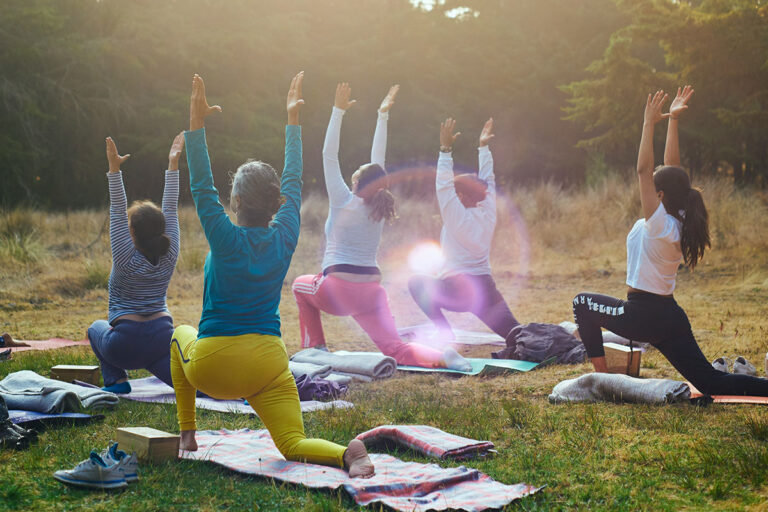Practical Wisdom from Patanjali’s Path to Inner Peace
Yoga is often associated with flexibility, fitness, and postures — but those are only a fraction of what yoga truly is. In the ancient text The Yoga Sutras of Patanjali, yoga is defined not by physical poses alone, but through an eightfold path known as the Eight Limbs of Yoga (Ashtanga Yoga).
These limbs offer a complete lifestyle guide — from ethics and self-discipline to mindfulness and spiritual liberation. When integrated into everyday life, they serve as a roadmap for personal growth, clarity, and balance.
Let’s explore how you can embrace the Eight Limbs of Yoga in your modern daily life.
🌿 1. Yama – Ethical Restraints (How We Relate to Others)
The Yamas are moral guidelines that help us live in harmony with the world around us.
The 5 Yamas:
- Ahimsa (Non-violence): Practice kindness in words, actions, and even thoughts. Avoid harm to others, the environment, or yourself.
- Satya (Truthfulness): Be honest with others and yourself. Speak truth, but with compassion.
- Asteya (Non-stealing): Avoid taking what isn’t yours — including time, energy, or credit.
- Brahmacharya (Moderation): Use your energy wisely. In daily life, this can mean balance in work, relationships, and consumption.
- Aparigraha (Non-possessiveness): Let go of greed and attachment. Declutter your space and thoughts.
👉 Daily Practice Tip: Reflect each evening — “Did I practice compassion, honesty, and restraint today?”
🔅 2. Niyama – Personal Disciplines (How We Relate to Ourselves)
Niyamas guide inner development and self-care.
The 5 Niyamas:
- Shaucha (Purity): Clean your body, surroundings, and thoughts.
- Santosha (Contentment): Be grateful and satisfied with what you have.
- Tapas (Discipline): Build habits that fuel growth, like regular practice or early rising.
- Svadhyaya (Self-study): Read spiritual texts, journal, and observe your thoughts.
- Ishvara Pranidhana (Surrender to the Divine): Let go of control. Trust a higher order.
👉 Daily Practice Tip: Begin your day with a morning ritual — such as breathwork, reading, or silent reflection.
🧘 3. Asana – Physical Postures
Most people know this limb best. Asanas are physical movements designed to prepare the body for meditation by building strength, flexibility, and stillness.
But Patanjali said:
“Asana should be steady and comfortable.” (Sutra 2.46)
👉 Daily Practice Tip: Practice even a few minutes of yoga each day with intention, not perfection. Tune into how your body feels, not how it looks.
🌬️ 4. Pranayama – Breath Control
Pranayama is about conscious breathing. It balances the nervous system, boosts mental clarity, and deepens awareness.
Simple Practices:
- Box Breathing (4-4-4-4)
- Alternate Nostril Breathing (Nadi Shodhana)
- Ujjayi (Ocean Breath)
👉 Daily Practice Tip: Pause during your workday to take 10 deep, mindful breaths. Notice how your state shifts.
👁️ 5. Pratyahara – Withdrawal of the Senses
This limb teaches us to turn inward by detaching from distractions. It’s not about ignoring the world, but about not being ruled by it.
In modern life, this means:
- Reducing screen time
- Sitting in silence
- Turning off notifications
- Choosing solitude over constant stimulation
👉 Daily Practice Tip: Set aside 10–15 minutes each day without devices, noise, or input. Simply be.
🎯 6. Dharana – Concentration
Dharana is focused attention — the ability to concentrate the mind on one thing without distraction.
It could be:
- Watching your breath
- Repeating a mantra
- Focusing on a candle flame
- Writing in a journal
👉 Daily Practice Tip: Practice single-tasking. When eating, just eat. When listening, truly listen.
🧘♂️ 7. Dhyana – Meditation
Dhyana is sustained, effortless meditation — the flow state of awareness. It arises from consistent practice of concentration.
You don’t “do” Dhyana. It’s what happens when you create the space for stillness.
👉 Daily Practice Tip: Start with 5–10 minutes of daily meditation. Let go of trying. Just observe.
✨ 8. Samadhi – Blissful Absorption
The final limb is Samadhi, or spiritual liberation — a state of oneness with the universe, free from ego and separation. It’s the ultimate goal of yoga, but not something we “achieve.” It unfolds naturally as we live the first seven limbs.
In daily life, you may glimpse Samadhi in:
- A moment of deep peace
- A sense of timelessness in meditation
- A feeling of awe in nature
- Pure presence with a loved one
👉 Daily Practice Tip: Don’t chase Samadhi. Let presence and devotion be enough.
🧭 Conclusion: Living Yoga Off the Mat
The Eight Limbs of Yoga are not abstract ideals — they are practical, powerful tools for modern life. Whether you’re navigating a traffic jam, a tough relationship, or just the pressure of daily routines, these ancient teachings help you stay:
- Grounded in values
- Centered in breath
- Aligned with purpose
Yoga isn’t something you practice once a day — it’s something you carry all day.Let each limb guide you, and you’ll find that yoga is not just a part of life… it is life, fully lived.



